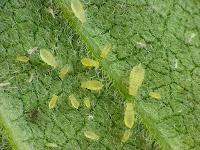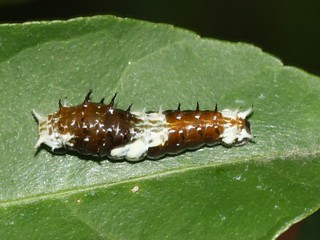The small seed fell on the fertile soil. After a rest period it swelled and
burst out of its case. It lifted its head and began to grow, enjoying the
sunshine and the rain water that penetrated the ground and bathed its small
roots. After a number of years, it became a significant member of the forest,
as large as some of its companions. It had become a tree. And that is what we
will call it from now on: Tree.
Tree follows an annual routine, each spring it covers itself with flowers, the
agents of a special contract with insect partners. It lures these partners with
the perfumed and brightly colored flowers. Tree provides them with nectar and
pollen and makes use of them to have its pollen carried to other members of its
species. The tiny partners are unaware of the pollination service they provide.
Tree uses them for its own purposes, to ensure the next generation and pays
them handsomely.
Once the flowers are pollinated, fruits grow, with seeds inside that will
complete the process of starting another generation. When the seeds are ready,
Tree resorts to other kind of attractants to call a second set of partners. The
fruits ripen, become sweet and nutritious and their colors turn bright inviting
birds and maybe squirrels or other small creatures as well as larger ones. Tree
provides them with sugars and vitamins, to induce them to carry the seeds some
distance, so Tree's descendants can spread far and wide.
Tree has relationships with many other members of the forest. Some are not
so friendly; they can even be costly. Tree resorts to other items in its
tool kit, including weapons and even hiring some allies of a different sort.
Multiple creatures feed on the leaves and other tissues of Tree. Most of the
time they don't cause serious damage because Tree uses its defenses to be
unpalatable, thus repelling a good number of them or limiting how much they can
eat. If things get out of hand Tree resorts to another defense: it calls
helpers, parasitic wasps, ready to lay their eggs on the damaging insects, thus
bringing down their populations and the damage that they might inflict on Tree
otherwise. If that defense isn't enough, Tree can count with the help of
several other enemies of its enemies, ladybugs, lacewings and a few others.
Tree doesn't know it, but even its enemies may provide it some benefits. Some of
them end up feeding the very birds that at other times take care of dispersing
Tree's seeds. So, it would be more appropriate to regard them as taxes, that
necessary evil, rather than enemies.
Thus, Tree is intertwined to the life of the forest in multiple ways above
ground. It is time that we take a look below ground, where the web of life is just
as intricate or even more so.
There are certain fungi, called mycorrhizae, that partner with Tree in an
intimate way. They are composed of very thin threads similar to rootlets but
thinner and far more abundant. They form an endless mesh wrapping around Tree's
roots and even penetrating them. They are not a threat but helpers. They
dramatically increase the reach of Tree's rootlets and they are far superior at
extracting water and essential minerals from the soil.
They render some of
these to Tree which, in return, pays its partner with nutrients produced by its
leaves. Not satisfied with that, mycorrhizae reach out to other trees and
plants, providing similar services. The remarkable thing is that they have the
faculty of carrying nutrients from one plant to another when a particular one
is under stress and the others are doing well. Thus, the partnership goes well
beyond Tree to the entire community.
Mycorrhizal interconnections don't stop there. They also interact with a
variety of soil bacteria. These bacteria, too, are very good at producing an
assortment of chemicals, some of them useful to the mycorrhizae and also to
Tree.
When mycorrhizae want to reproduce, they form the familiar mushrooms often
seen on the forest floor. Other mycorrhizae produce truffles instead. Now, it
is time for another partner to enter the scene. The mushroom or truffle is
nutritious to many forest creatures, beetles, squirrels, flying squirrels. They
seek the mushroom or truffle's flesh, swallowing some spores along with it.
Later on, they pass the spores at some distance, where new mycorrhizae can grow
away from the parent and develop a relationship with other plants.
Tree sheds its leaves every year. These would accumulate to the point of
smothering the soil if it wasn't for the work of other helpers. A wide array of
insects, fungi, bacteria, nematodes slowly chews away all this matter. It takes
them years to return all the nutrients to the soil but they accomplish this
task.
I probably left out many other partners of Tree. But this
could suffice for now. We can firmly conclude that no tree is an island. No
other creature is an island either, all joined together in the Web of Life.
© Beatriz Moisset. 2012












































